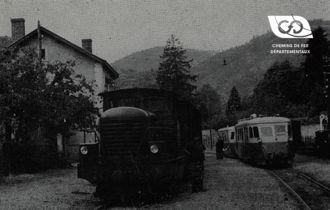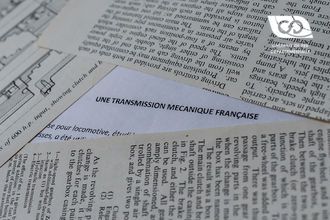HOW THE CONTROL SYSTEM WORKS
On each gearbox there is a distributor that directs air to the Cv cylinders. This distributor is remotely controlled from the mechanic's desk, by means of a three-way valve A, B, C, - which we'll designate when they're supplied with compressed air by AAAp - Bp - Cp or escape by A0 - B0 - C0 - , thus gives the following eight combinations, each corresponding to a speed:
- 1st A Bp Cp 5th Ao Bp Cp
- A Bp Co 6th Ao Bp Co Co 6th Ao Bp Co
- A Bo Cp 7th Ao B C C 7th Ao B C
As the preselection is made on a combination, the impulse has the effect of moving the spool of the two-way valve (D). to the right
This one by its channel 1 supplies the clutch-brake (Ef), the engine idling (Mr) and the direct solenoid valve (EV) on the supply side.
By its track 2 it releases the rod lock (F) which under the action of its spring is released upwards unlocking the three rods.
As soon as the gearbox is stopped, and this about a second to a second and a half after the impulse, the oil pressure of the gearbox pump (P(Pb drops to zero, the pressure switch (M) establishes the current on the solenoid valve (Ev) which admits the air to the gear distributor (Dv). The latter feeds the different cylinders giving the previously chosen combination, while, thanks to the retarder (R), a fraction of a second after opening of the solenoid valve, the air comes via the double valve (Vv to pressurise the rod lock (V) ; as soon as the rods are all in position, this one comes to be pushed down from top to bottom, controlling at the end of the stroke the valve (Z), which brings back towards the left the spool (D) whose track (1) is put at the exhaust, releasing the brake, engaging and putting back the injection of the engine.
While channel (2) comes via the double valve (V) to take over, to keep V locked.
The control of several boxes is identical, and a simple pulse triggers their operation. In order not to interrupt the tractive effort, it is then sufficient to place calibrated retarders on the tracks (I) of the (D), valves, the effect of which is to trigger the operation at different times on each box.
It should be noted that, thanks to the presence of the freewheel, it is possible to engage any combination of gears in the gearbox, whatever the speed of the vehicle, and that this control allows you to switch from any combination to any other.





